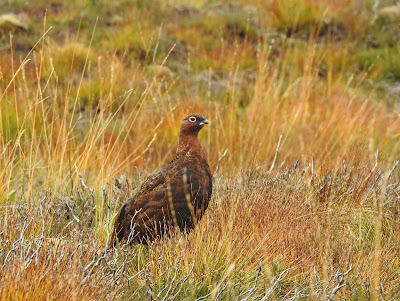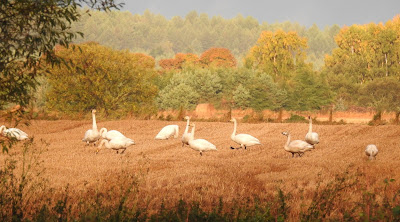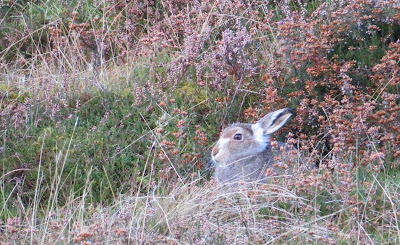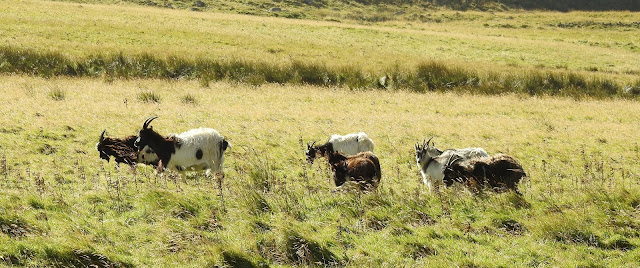Wildlife highlights included:
Local speciality bird species seen regularly during the month included:
Crested Tit, ,
Red Grouse, Dipper and
Goldeneye, we also had several good sightings of
Golden Eagle and
Hen Harrier, a few fleeting glimpses of
Crossbills, The
Black Grouse began to show from mid-month again at known lek sites, with up to 6 male birds being seen soon after first light, and we had one brief dawn view of a male
Capercaillie............
Ptarmigan and
Snow Bunting were both seen on a walk up Cairngorm Mountain late in the month, and newly-arrived winter visiting birds were represented by
Whooper Swans, several species of 'grey'
Geese, Redwings and
Fieldfares.
A good variety of
waders and
wildfowl were seen at the
Moray Coast, a few
Waxwings were reported locally at the end of the month...and even a couple of
Yellow-Browed Warblers and 2
Snow Geese and 2
Red Breasted Geese were reported nearby....
Mammal species seen regularly included:
Red Squirrel,
Red Deer,
Reindeer,
Roe Deer,
Mountain Goat ,
Brown Hare and
Rabbit......with just a few views of
Mountain Hare and
Bank Vole, an unusual sighting of 3
Brown Rats using a hanging peanut feeder!!, and one brief glimpse of a
Stoat.....The second half of the month also saw us enjoy great views of
Atlantic Salmon starting to spawn in the upper reaches of our local rivers....
 |
| Crested Tit |
Crested Tits, having been generally 'uncooperative' through the summer months, started to become more regular visitors to forest feeding stations, especially soon after dawn, and we were fortunate enough to enjoy some excellent and often extremely close views of this true 'local speciality' on a number of occasions....
A bonus by-product of regular winter feeding is sometimes (on colder days) being able to feed the incredibly confiding Coal Tits and (sometimes) Great Tits by hand, an experience much enjoyed by my safari clients...
Still in the forests,
Crossbills, sadly, but not unusually, were somewhat less obliging however, with our views once again being restricted to snatched glimpses of birds flying overhead...identified only by their distinctive 'jip- jip' calls....
 |
| Red Grouse |
Our local
Red Grouse appeared to still be in their (sadly now smaller) family groups, but with the shooting season virtually over, they seem a little less wary and can be a bit easier to see, especially when using my safari vehicle as a slow-moving mobile hide on the quiet tracks through their heather moorland home.
 |
| Dipper by Nigel Wedge |
Dipper is a bird absent from large areas of central, southern and eastern Britain, preferring clear, fast-flowing upland rivers over murky, slow-flowing lowland waterways. Fortunately, it is a fairly common sighting in this area, often perching prominently on a rock, and always proves popular with my safari clients ...
 |
| Golden Eagle |
Golden Eagle is truly an iconic bird of the Scottish Highlands, and our regular visits to my favourite upland glens paid off on numerous occasions, with a number of very decent sightings of these hugely impressive creatures, sometimes hunting , and often in aerial combat with other raptors....
 |
| Male Hen Harrier by Nigel Wedge |
Early winter is always our best time of year for raptor sightings, and this month we also recorded views of
Hen Harrier (male and female), Goshawk, Peregrine, Kestrel, Sparrowhawk, Red Kite, and numerous
Common Buzzards...
 |
| Ptarmigan |
The aforementioned walk up Cairngorm Mountain (on the 26th) produced great views of 12
Ptarmigan, now morphing nicely into their winter-white plumage, which were actually quite obliging, allowing some decent photo opportunities, though the solitary
Snow Bunting we saw refused to pose nicely for us!
 |
| Whooper Swans |
The Moray coast is only about an hours drive north west of Aviemore, and a couple of trips to favourite reserves, bays and harbours gave good views of incoming winter migrants such as
Greylag Geese,
Barnacle Geese,
Pink-Footed Geese,
Brent Geese,
Whooper Swan,
Wigeon,
Teal,
Pintail,
Bar-Tailed Godwit,
Knot, Golden Plover and
Grey Plover....
 |
| Redwing |
Winter thrushes flooded into our area from their summer breeding areas further north, first the
Redwings, followed soon after by the
Fieldfares, and they soon set about tucking into our local berry supplies, much to the annoyance of our resident
Blackbirds and
Thrushes!
 |
| Fieldfare |
Other good birds seen locally this month included: Brambling, Redpoll, , Scaup, and Kingfisher....
Onto mammals now....
 |
| Red Deer stag |
'Mammal of the month' for October has to be the
Red Deer, with their spectacular annual 'rut' providing my safari clients with some superb entertainment - the fully antlered stags 'bolving' roars echoing through the glens, as they spend much of the month posturing , fighting off rivals and attempting to mate with as many of their 'harem' as possible - surely one of British nature's 'must-see' experiences?
 |
| Mountain Hare |
Still up in the glens, our local
Mountain Hares, though still in their browny-grey summer coats are gradually turning whiter from their feet upwards as autumn progresses, in preparation for the snow to come, though actual sightings of them were not as frequent, or as good as I would have liked... but that is not unusual during the 'warmer' months..things should hopefully change next month....
Although not as physically impressive as their Red cousins, Roe Deer are probably more often described as cute, but always seem to prove popular with my safari clients, and we were fortunate enough to see them frequently this month, usually on marshland and woodland fringes, and occasionally on farmland, especially soon after dawn....though a decent photo escaped me ...
 |
| Red Squirrel |
In the forests, our
Red Squirrels never failed to entertain, with their cute looks, acrobatic use of peanut feeders, and chasing off of rivals, and of course, with them being largely absent from most of the UK now, many of my safari clients were seeing them for the first time....
 |
| Feral Mountain Goats |
Feral Mountain Goats are mainly restricted to a few remote upland areas of the UK, and we are fortunate to have them locally in a few quiet glens, so many of my safari clients get to see them for the first time while out with me....
 |
| Brown Rats |
Brown Rat is not a common sighting on my safaris, but we were fortunate to see no less than 3 using a hanging peanut feeder on the 26th......
 |
| Spawning Atlantic Salmon |
Mid October-mid November is the time of year to see our Atlantic Salmon spawning. These remarkable and often very large fish spawn in the shallow waters in the upper reaches of our rivers, at the very spot where they themselves were hatched several years before, having originally spent 2-3 years in the river, then another 2-3 years feeding, growing and maturing out in the mid Atlantic, before undertaking a perilous journey many miles upriver, often involving avoiding poachers and predators and negotiating high falls and rapids on the way - an amazing migration story! However, sightings are very reliant on the rivers water levels - too little water and the Salmon cannot access the upper reaches - too much water, and they can get there... but we can't see them. This time we got lucky with everything falling into place, and good sightings were enjoyed from mid-month onwards ...
So, to summarise, helped by the reasonably friendly weather, the annual Red Deer rut, and the miracle of migration, October 2017 turned out to be yet another very enjoyable month for wildlife watching in the Cairngorms National Park, with plenty of excellent sightings, many memorable experiences, lots of happy safari clients, and the odd surprise, and all set against beautiful autumnal Highland backdrops.......
If you think you know someone who may enjoy a taste of what I do, why not treat them to a safari gift certificate. They make a thoughtful and imaginative present and are available for any amount in multiples of £10, and are valid at any time within a year from date of purchase....
 |
| An atmospheric image of a local loch |








